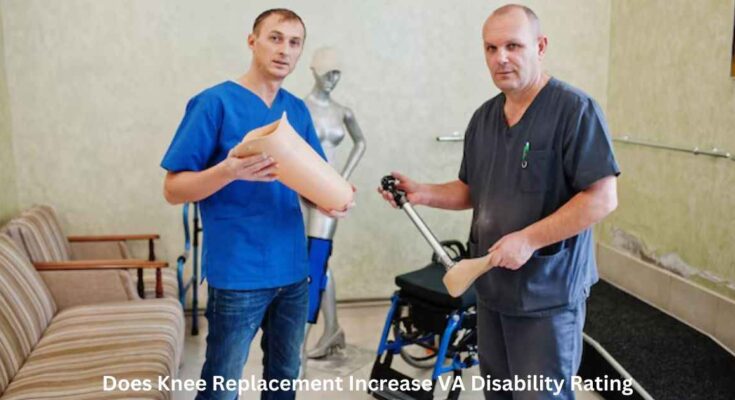Knee replacement surgery is joint among veterans who have sustained injuries or developed conditions affecting knee joints. One crucial question often arises: Does knee replacement increase VA disability rating? This article aims to answer that question by exploring the relationship between knee replacement surgery and VA disability ratings, providing a comprehensive guide for veterans considering or undergoing this procedure.
Understanding Knee Replacement
What is Knee Replacement?
Knee replacement, also known as knee arthroplasty, is a surgical procedure that replaces a damaged or diseased knee joint with an artificial implant. This procedure is typically recommended for patients experiencing severe pain and reduced mobility due to arthritis, injury, or other knee-related conditions.
Common Reasons for Knee Replacement
Veterans may require knee replacement due to various reasons, including osteoarthritis, rheumatoid arthritis, post-traumatic arthritis, or knee injuries sustained during military service. These conditions can lead to significant pain and mobility issues, affecting a veteran’s quality of life.
Procedure Overview
The knee replacement procedure involves removing and replacing the damaged joint surfaces with metal and plastic components. The surgery aims to alleviate pain, improve function, and enhance patients’ overall quality of life.
VA Disability Rating System
What is the VA Disability Rating?
The VA disability rating is a percentage assigned to a veteran’s service-connected disability, reflecting the severity of the condition and its impact on their ability to work and perform daily activities. The ratings range from 0% to 100%, in increments of 10%, with higher ratings indicating more severe disabilities.
How VA Ratings Are Determined
VA ratings are determined based on the VA Schedule for Rating Disabilities (VASRD), which provides specific criteria for evaluating various medical conditions. Factors considered include the severity of symptoms, limitations in range of motion, and the overall impact on the veteran’s ability to function.
How Knee Conditions Affect VA Disability Rating
Common Knee Conditions for Veterans
Due to the physical demands of military service, veterans may experience knee conditions such as meniscal tears, ligament injuries, and arthritis. These conditions can lead to chronic pain, instability, and decreased range of motion, significantly impacting a veteran’s daily life.
Impact on Daily Life
Knee conditions can make it challenging for veterans to perform everyday tasks, such as walking, climbing stairs, or standing for extended periods. This can lead to reduced mobility, pain, and decreased quality of life, often necessitating medical intervention, such as knee replacement surgery.
Does Knee Replacement Increase VA Disability Rating?
Factors Influencing VA Ratings
Several factors can influence whether a knee replacement surgery leads to an increased Does knee replacement increase VA disability rating. These include the severity of the knee condition before surgery, the surgery’s success, and any complications or ongoing symptoms.
Post-Surgery Rating Evaluation
After knee replacement surgery, the VA may reevaluate the veteran’s disability rating. The new rating will depend on pain levels, range of motion, and the ability to perform daily activities. Sometimes, a temporary 100% disability rating may be assigned during the recovery period, followed by a reassessment to determine the long-term rating.
The Process of Applying for a Rating Increase
Steps to Apply for an Increased Rating
Veterans seeking an increased VA disability rating after knee replacement surgery should follow these steps:
- Gather medical records and documentation related to the knee condition and surgery.
- Present a case for an expanded rating to the VA.
- Attend a Compensation & Pension (C&P) exam to assess the severity of the condition.
Required Documentation
Documentation required for a rating increase includes medical records, surgical reports, physician statements, and evidence of ongoing symptoms or complications. Providing comprehensive and accurate documentation is crucial for a successful claim.
Case Studies and Examples
Success Stories
Many veterans have successfully increased their VA disability rating after knee replacement surgery. These success stories often involve veterans who experienced significant pain relief and improved mobility post-surgery, leading to a reassessment of their disability rating.
Challenges Faced by Veterans
Some veterans face challenges when applying for a rating increase, such as difficulty obtaining necessary documentation, navigating the VA claims process, or proving the severity of their condition. Understanding these challenges can help veterans prepare and improve their chances of a successful claim.
Expert Opinions
Quotes from Orthopedic Specialists
Orthopaedic specialists emphasise the importance of proper documentation and clear communication with the VA to ensure a fair evaluation of the veteran’s condition post-surgery. “Veterans should work closely with their healthcare providers to document the impact of knee replacement surgery on their daily lives,” says Dr Smith, a leading orthopaedic surgeon.
Insights from VA Disability Advisors
VA disability advisors suggest that veterans seek assistance from Veterans Service Organizations (VSOs) or VA-accredited representatives to navigate the claims process. These professionals can provide valuable guidance and support throughout the application process.
Impact of Knee Replacement on Quality of Life
Physical Benefits
Knee replacement surgery can significantly improve a veteran’s quality of life by reducing pain, increasing mobility, and allowing for greater participation in daily activities. This can lead to enhanced physical and mental well-being.
Psychological Impact
The relief from chronic pain and improved mobility can positively impact a veteran’s mental health, reducing feelings of frustration, depression, and anxiety associated with knee conditions. Improved quality of life can lead to better mental health and a more positive outlook.
Common Misconceptions
Myths About VA Disability and Knee Replacement
Common misconceptions exist about the relationship between knee replacement and Does knee replacement increases VA disability rating. Some veterans believe knee replacement surgery will automatically result in a higher rating, but this is not always true. The outcome depends on the individual circumstances and the success of the surgery.
Clarifications
Veterans need to understand that knee replacement surgery can increase their rating, but it is not guaranteed. The VA evaluates each case based on the severity of the condition and its impact on the veteran’s life.
Alternative Treatments and Their Impact
Physical Therapy
Physical therapy is a non-surgical option to help manage knee pain and improve mobility. For some veterans, physical therapy may be sufficient to alleviate symptoms, potentially avoiding the need for surgery.
Medication
Medications like pain relievers and anti-inflammatory drugs can also help manage knee pain. However, these treatments may not provide long-term relief for severe knee conditions, and surgery may be necessary.
Future Outlook
Advances in Knee Replacement Technology
Ongoing advances in knee replacement technology promise improved patient outcomes. Innovations such as minimally invasive techniques, advanced materials, and robotic-assisted surgery are expected to enhance the effectiveness of knee replacements.
Trends in VA Disability Evaluation
The VA updates its evaluation criteria to reflect medical treatment and technology advances. Staying informed about these changes can help veterans better understand their options and improve their chances of a successful claim.
Conclusion
Knee replacement surgery can potentially increase a veteran’s VA disability rating, but it is not guaranteed. Understanding the VA rating system, gathering the necessary documentation, and seeking professional guidance is essential for veterans seeking an increased rating. By taking proactive measures, veterans can improve their chances of a successful outcome and enhance their quality of life.






